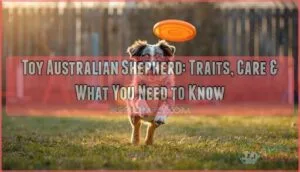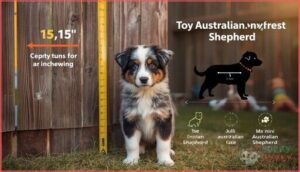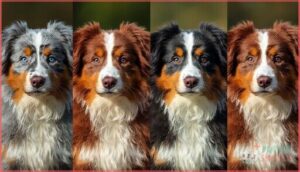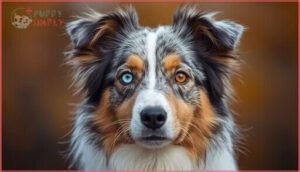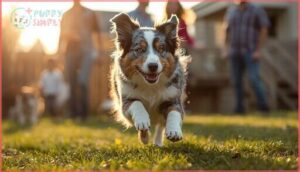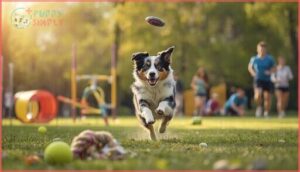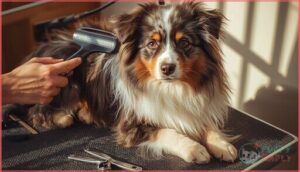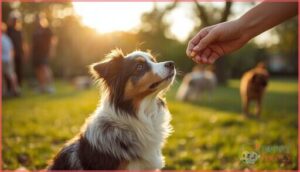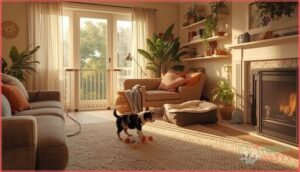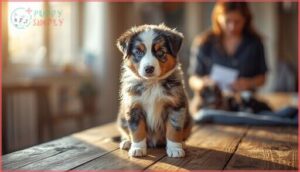This site is supported by our readers. We may earn a commission, at no cost to you, if you purchase through links.
The Toy Australian Shepherd packs the full personality of a working ranch dog into a pint-sized package—and that’s exactly what catches most new owners off guard. These aren’t scaled-down couch potatoes. They’re intelligent, high-energy herders who’ll round up your kids, your other pets, and possibly your houseguests if they don’t get enough mental and physical work.
Standing just 10-14 inches tall and weighing 12-17 pounds, they demand the same training commitment as their larger cousins. If you’re drawn to their stunning merle coats and compact size, you need to understand what actually drives this breed.
The right environment and approach transforms them into outstanding companions, but cutting corners leads to anxious, destructive behaviors that overwhelm unprepared families.
Table Of Contents
- Key Takeaways
- Toy Australian Shepherd Origins
- Physical Characteristics of Toy Aussies
- Typical Temperament and Personality
- Exercise and Activity Needs
- Nutrition and Feeding Guidelines
- Grooming and Coat Maintenance
- Common Health Concerns
- Training and Socialization Tips
- Living Environment and Home Safety
- Choosing a Toy Australian Shepherd
- Frequently Asked Questions (FAQs)
- What is the average lifespan of a toy Australian shepherd?
- How much does a toy Australian shepherd puppy cost?
- Are toy Australian shepherds easy to potty train?
- Do toy Australian shepherds do well in apartments?
- Is pet insurance recommended for toy Australian shepherds?
- Can Toy Australian Shepherds compete in AKC events?
- Do Toy Aussies get along with cats?
- Are Toy Australian Shepherds good for seniors?
- How do Toy Aussies handle hot weather?
- Can Toy Australian Shepherds be service dogs?
- Conclusion
Key Takeaways
- Toy Australian Shepherds aren’t lap dogs—they’re 10-14 inch herding machines that demand 60+ minutes of daily exercise plus serious mental stimulation, or you’ll deal with destructive anxiety and behavioral chaos.
- These dogs carry genetic health risks like MDR1 mutation (affecting 25% of the breed) that causes dangerous drug sensitivities, plus eye disorders and hip dysplasia, making genetic testing non-negotiable before bringing one home.
- Their intelligence cuts both ways—they master commands quickly but need constant engagement through puzzle toys, training sessions, and enrichment activities, because a bored Toy Aussie will “manage” your household in ways you won’t appreciate.
- Budget realistically for $800-$3,500 upfront plus $70-$120 monthly ongoing costs, and understand that apartment living only works if you’re committed to meeting their relentless exercise needs every single day for 12-15 years.
Toy Australian Shepherd Origins
You might think the Toy Australian Shepherd has been around forever, but this pint-sized version of the Aussie actually has a pretty recent backstory. Breeders started selectively downsizing standard Australian Shepherds to create a compact companion that kept all the smarts and drive of the original.
Let’s look at how this breed came to be and what sets it apart from its larger cousins.
Breed History and Development
The Toy Australian Shepherd’s origin story traces back to 1960s California, when breeders like Doris Cordova launched selective breeding programs for smaller Aussies. While the Australian Shepherd itself developed in California—not Australia—for herding, these toy variations emerged through purposeful miniaturization in the 1990s.
The American Stock Dog Registry certifies them as purebred, though major kennel clubs haven’t granted breed recognition yet. Understanding the breed history is essential for potential owners.
Differences From Standard and Miniature Aussies
Size comparison reveals that Toy Australian Shepherds max out at 14 inches and 12-17 pounds, while Mini Australian Shepherds—recognized as Miniature American Shepherds—reach 13-18 inches and 20-40 pounds. Standard Australian Shepherds tower at 18-23 inches, weighing 40-65 pounds. Breed recognition splits them: standards and minis have AKC status, but toy versions don’t.
Despite genetic variance from miniaturization breeding, all three herding dog sizes share similar health differences, training needs, and that signature Aussie intelligence. Understanding the dog growth charts is essential for monitoring their development.
Physical Characteristics of Toy Aussies
Toy Aussies pack a lot of personality into a compact frame, but their size isn’t the only thing that sets them apart. From their sturdy build to their striking coat patterns and expressive faces, these dogs turn heads wherever they go.
Let’s break down what makes them so visually distinctive.
Size and Weight Range
These pint-sized powerhouses stand 10 to 14 inches tall at the shoulder and tip the scales between 12 and 17 pounds. Height factors define breed standards—anything under 14 inches qualifies as a Toy Australian Shepherd rather than a Mini Australian Shepherd.
Males usually hit the upper weight limits, while females stay lighter. Growth patterns show they’ll reach full size by 18 months to 2 years.
Coat Types and Color Patterns
Beyond their compact frame, your Toy Australian Shepherd sports a weather-resistant double coat that’s straight to slightly wavy. You’ll find four stunning coat colors: blue merle, red merle, black tri-color, and red tri-color. Merle traits create that eye-catching mottled pattern, often paired with striking blue or amber eyes.
Shedding patterns bring twice-yearly blowouts, so grooming tips matter—brush weekly to manage coat genetics and keep color variations vibrant.
Distinctive Facial Features
Picture that collie-like face—clean, strong, and athletic. Your Toy Australian Shepherd has a muzzle that’s equal to or slightly shorter than the back skull, creating a balanced head shape.
Eye colors range from brown and amber to blue, green, or even heterochromia (two different colors).
Triangular ears fold high on the head, though some Toy Aussies show floppier, hound-like ears depending on breeding lines.
Typical Temperament and Personality
Toy Australian Shepherds pack a lot of personality into a compact frame. Their temperament is shaped by the same working-dog genetics that made standard Aussies such reliable herders—just scaled down.
Here’s what you can expect from their behavior, social habits, and that signature energy they’re known for.
Intelligence and Trainability
Think of your Toy Australian Shepherd’s mind like a sponge—they rank around 42nd in canine intelligence but excel at problem solving and adaptive learning. You’ll notice their intelligent behavior through:
- Quick mastery of commands in 25-40 repetitions
- Sharp memory retention spanning years
- Creative solutions to physical challenges
Dog training tips work best with positive reinforcement and clickers. Their trainability shines when you provide consistent mental stimulation, though stubbornness requires patient, engaging dog training methods.
Social Behavior With Families
Your Toy Australian Shepherd bonds deeply with family members, often showing fierce loyalty and affection that rivals any companion dogs. They thrive on social learning, absorbing household harmony through consistent bonding techniques and relationship building. Early socialization ensures your family dog adapts well to children and varied family dynamics.
| Family Member | Interaction Style | Best Approach |
|---|---|---|
| Adults | Devoted, attentive | Include in daily activities |
| Children | Playful, protective | Supervise early interactions |
| Seniors | Gentle, adaptable | Provide calm engagement |
Herding Instincts and Energy
Your Toy Australian Shepherd’s herding instincts kick in early—sometimes by 6-8 months—driving them to chase, nip, and strategically position themselves around moving targets. These intelligent dogs need serious outlets for their working-dog heritage, or you’ll find them “managing” your household in creative ways.
- Expect at least 60 minutes of vigorous daily exercise to burn off their relentless energy levels
- Channel herding behavior through agility training, flyball, or structured fetch sessions
- Provide mental stimulation with puzzle toys and obedience work to prevent anxiety
- Watch for nipping at children’s heels—a classic herding instinct that needs redirection
- Split exercise needs into two sessions to keep energy levels manageable throughout the day
Exercise and Activity Needs
Don’t let that small size fool you—Toy Aussies pack the energy of a full-sized working dog into a compact frame. Without proper outlets, that drive can turn into restlessness, barking, or unwanted behaviors around the house.
Let’s break down what your Toy Aussie needs to stay balanced and content.
Daily Physical Exercise Requirements
Your Toy Australian Shepherd needs 1 to 1.5 hours of physical activity daily to stay healthy and balanced. Split exercise routines into two sessions—think brisk daily walks, fetch, or agility training.
These herding dog breeds thrive on variety, so mix up play sessions with swimming or hiking. Without adequate dog exercise, you’ll see anxiety and destructive behaviors creep in.
Puppies require shorter bursts, while adults demand consistent fitness levels.
Mental Stimulation and Enrichment
Mental stimulation tires your Toy Australian Shepherd just as much as a long run—and sharpens canine intelligence in the process. These intelligent dogs need cognitive training daily to prevent destructive habits and keep anxiety at bay.
Here are five brain stimulation essentials:
- Puzzle toys that challenge problem-solving skills
- Interactive toys dispensing treats during play
- Hide-and-seek games strengthening your bond
- Snuffle mats encouraging natural foraging
- New trick training using positive reinforcement methods
Mental exercise matters, especially for Toy Australian Shepherd training success.
Nutrition and Feeding Guidelines
Feeding your Toy Aussie the right way isn’t complicated, but it does matter more than you might think. These little athletes burn through energy fast, and their nutritional needs are different from larger breeds.
Let’s break down what you need to know about keeping your pup properly fueled and healthy.
Essential Nutritional Needs
Your Toy Australian Shepherd’s energy and muscle mass depend on a protein-rich diet—at least 25% from chicken, beef, or fish. Fat requirements sit around 12-16%, delivering omega-3s for that glossy coat. These pint-sized dynamos need 200-275 calories daily, paired with essential vitamins like D3 and minerals such as zinc to support bone health and immune function.
| Nutrient | Recommended Amount | Key Benefits |
|---|---|---|
| Protein Sources | 25%+ of diet | Muscle development, energy |
| Fat Requirements | 12-16% of diet | Coat health, brain function |
| Caloric Intake | 200-275 cal/day | Sustained energy, weight control |
| Vitamin Needs | Calcium, D3, B-complex | Bone strength, metabolism |
| Mineral Supplements | Zinc, iron, copper | Immune support, coat quality |
Feeding Schedules and Treat Recommendations
Split your Toy Australian Shepherd’s daily calories into two meals—morning and evening work best for managing their high metabolism. Puppies need 3-4 feedings until six months, then scale back.
For treats, opt for soft jerky during training or crunchy dental chews between meals. Keep treats under 10% of daily intake, and watch those portions—consistency prevents overeating while supporting your pup’s energy needs.
Grooming and Coat Maintenance
That beautiful coat isn’t maintenance-free—it takes consistent care to keep your Toy Aussie looking sharp and feeling comfortable.
You’ll need the right approach to manage shedding, prevent mats, and keep everything from their paws to their teeth in good shape.
Here’s what you need to stay on top of.
Brushing Techniques and Tools
You’ll want to brush your Toy Australian Shepherd at least once weekly, ramping up to daily sessions during spring and fall when shedding peaks. The right grooming tools make all the difference in coat maintenance and mat removal for this dog breed.
- Slicker brushes with fine wire bristles tackle loose fur and detangle the topcoat
- Undercoat rakes with long teeth thin the dense undercoat during heavy shedding control periods
- Pin brushes distribute natural oils and work well for daily Australian Shepherd grooming
- Metal combs catch missed tangles in tight spots like behind ears
- Bristle brushes smooth and finish the outer coat layer beautifully
Bathing and Shedding Control
Once you’ve brushed out those tangles, it’s smart to bathe your Toy Australian Shepherd every 6–8 weeks. Overdoing baths strips essential oils, making shedding worse and the coat dull. Stick to dog-specific shampoos for healthy skin and better shed control.
During spring and fall, ramp up grooming—daily brushing and occasional de-shedding products keep fur under control.
Nail, Ear, and Dental Care
Beyond coat care, your Toy Aussie needs solid nail trimming, ear cleaning, and dental hygiene to stay comfortable and healthy. Trim nails every 1–2 months to prevent overgrowth, inspect ears weekly for infections, and brush teeth daily with dog-safe toothpaste to fight tartar buildup.
Monthly grooming tips include:
- Check paws for cracks or splinters
- Wipe ears gently with a damp cloth
- Offer dental chews between brushing
- Watch for bad breath signaling gum disease
Consistent pet care prevents painful problems down the road.
Common Health Concerns
Toy Australian Shepherds are generally healthy little dogs, but like any breed, they come with their own set of potential health challenges you should know about. Some of these issues are genetic, while others relate to their unique size and breeding.
Let’s walk through the main health concerns so you can stay one step ahead and keep your Toy Aussie thriving.
Genetic Health Issues
Your Toy Aussie’s genetic blueprint can hide some serious health problems that won’t show up until later. Eye disorders like Collie Eye Anomaly and Progressive Retinal Atrophy are common hereditary diseases in the breed, alongside hip dysplasia and neurological conditions.
Genetic testing helps you identify carriers and affected dogs early—it’s your best tool for managing canine health before symptoms appear.
MDR1 Mutation and Drug Sensitivities
One silent genetic threat affects about 25% of Australian Shepherds—the MDR1 mutation causes dangerous drug interactions your Toy Aussie can’t metabolize.
Genetic testing with a simple cheek swab reveals if your dog carries this mutation, helping you avoid toxicity prevention disasters with ivermectin, loperamide, and certain chemotherapy agents.
Breed screening isn’t optional—it’s life-saving canine health insurance for your Australian Shepherd.
Average Lifespan and Wellness
Your Toy Aussie’s 12 to 15-year lifespan depends heavily on proactive canine health management—and some live past 16 with proper care.
Lifespan factors include genetic testing for MDR1 and eye disorders, annual health screening appointments, and wellness plans that address joint health early.
Longevity tips? Keep your dog lean, mentally stimulated, and pair with breeders who prioritize animal health and wellness through multi-generational testing.
Training and Socialization Tips
Training a Toy Australian Shepherd isn’t complicated, but it does require consistency and the right approach. These smart little dogs pick up on patterns fast, so how you train them from day one matters more than you might think.
Let’s break down the most effective methods to help your Toy Aussie become a confident, well-adjusted companion.
Positive Reinforcement Methods
Ever wonder why Toy Australian Shepherds light up during Clicker Training? Their sharp minds crave clear Reward Systems.
Food treats, toys, and praise tap into their natural Dog Motivation, making Training Techniques feel like play.
For Intelligent Dog Breeds, positive reinforcement isn’t just Behavioral Modification—it’s the secret sauce for shaping Canine Behavior and building trust in Dog Training and Behavior.
Addressing Separation Anxiety
Ever notice your Toy Australian Shepherd glued to your side? That’s Canine intelligence mixed with anxiety triggers. Separation anxiety isn’t just whining—it’s escape attempts, agitation, and owner-scented destruction.
Separation anxiety in Toy Australian Shepherds goes beyond whining—it manifests as escape attempts, agitation, and destructive behavior targeting your belongings
Separation strategies like gradual alone-time, chew toys, and environmental enrichment work wonders. Calming techniques and owner support—think food puzzles and extra walks—help reshape dog behavior, making your absence less of a crisis.
Socializing With People and Pets
Your Toy Australian Shepherd craves Social Bonds—this breed’s all about strong Human Connection and Family Dynamics. Early Socialization shapes Dog Behavior, turning wary pups into confident, Loyal Companions.
Mix up Pet Interaction: short walks, puppy playdates, and gentle introductions. Canine Communication matters, so watch for nipping or herding. With patience, you’ll raise a well-mannered companion dog.
Living Environment and Home Safety
Toy Australian Shepherds can adapt to all sorts of living spaces, but their safety and happiness depend on how you set things up. Every home comes with its own challenges and opportunities.
Here’s what you’ll want to keep in mind when choosing the right enclosure for your pup.
Apartment and House Suitability
In city life, Space Requirements for a Toy Australian Shepherd can feel like urban planning for a tornado. Apartment Living works if you’re bold—think daily sprints, mental games, and clever Residential Adaptation. House Benefits shine with open yards and fewer noise headaches. For this Apartment dog among Small dog breeds, Dog exercise needs run the show.
- Daily walks
- Indoor play
- Bark management
- Designated rest area
- Outdoor access
Safe Toys and Enrichment Activities
Beyond square footage, your Toy Australian Shepherd craves brain work—that’s where Durable Toys and Interactive Games shine. Opt for Safe Materials like firm rubber treat puzzles and solid KONG balls to satisfy Canine intelligence without dental damage.
Mental Stimulation through hide-and-seek, scent treasure hunts, and DIY obstacle courses keeps destructive boredom at bay. For Small Dog Care, Enrichment Activities aren’t extras—they’re survival tools for a clever breed.
Creating a Secure Space
Safe Zones start with solid Secure Fencing—at least 40 inches tall to prevent your Toy Australian Shepherd from vaulting over. Crate Training gives them a den-like retreat, while Puppy Proofing means stashing cords, chemicals, and choking hazards.
Lock down gates and doors for Escape Prevention, then layer in water access and cozy bedding. This Dog Care Advice transforms Pet Care and Health into real peace of mind.
Choosing a Toy Australian Shepherd
Choosing the right Toy Australian Shepherd starts long before you bring a puppy home. You’ll want to find a breeder who prioritizes health and temperament, understand what kind of dog will actually fit your lifestyle, and get real about the financial commitment ahead.
Let’s break down what you need to think about before making this decision.
Finding Responsible Breeders
You’ll want to interview breeders who provide health certifications for MDR1 mutation and hip clearance—responsible breeding isn’t negotiable. Look for breed club membership, transparent puppy contracts outlining guarantees, and breeders who screen you as thoroughly as you screen them.
Toy Australian Shepherd breeders invested in dog breeding and genetics will encourage facility visits, share complete health records, and prioritize responsible pet ownership over quick sales.
Assessing Temperament and Compatibility
Compatibility depends on emotional intelligence—your ability to read a pup’s social adaptation cues during visits. Observe how they handle family dynamics: do they greet you with curiosity or retreat?
Intelligent dogs like Toy Australian Shepherds reveal temperament through relationship-building moments. Test their socialization by introducing gentle handling and novelty.
A loyal companion dog shows confident curiosity, not fearfulness or aggression.
Cost and Ongoing Care Considerations
Budgeting for a Toy Australian Shepherd means planning beyond the $800–$3,500 initial purchase price.
Monthly expenses for Toy Australian Shepherd care—food, veterinary fees, and grooming costs—average $70–$120. Don’t overlook insurance options, ranging from $10–$100 monthly, which cushion unexpected health emergencies.
Factor in first-year supplies and spay/neuter veterinary fees too. Smart pet care advice: responsible dog care requires financial commitment matching your pup’s 12–15 year lifespan.
Frequently Asked Questions (FAQs)
What is the average lifespan of a toy Australian shepherd?
You can expect your Toy Australian Shepherd to live 12 to 15 years, though outstanding care and genetic testing can push that to Diet impact, health issues, and longevity tips matter considerably.
How much does a toy Australian shepherd puppy cost?
Bringing home a pint-sized pup is no small investment. Toy Australian Shepherd puppies generally cost $1,000 to $2,500, though adoption fees run much lower at $200 to $500 through rescues.
Are toy Australian shepherds easy to potty train?
Yes, they’re generally easy to potty train thanks to their intelligence and eagerness to please. However, their smaller bladders mean more frequent outdoor trips and patience—usually four to six months for full housebreaking success.
Do toy Australian shepherds do well in apartments?
It’s not all sunshine and rainbows—Toy Australian Shepherds can handle apartment living if you nail their exercise needs, mental stimulation, and noise control.
Space management matters less than meeting their daily activity requirements consistently.
Is pet insurance recommended for toy Australian shepherds?
Pet insurance offers valuable financial protection for your Toy Aussie. With hereditary health risks like hip dysplasia and eye disorders, coverage helps manage unexpected veterinary costs ranging from routine care to emergency treatments efficiently.
Can Toy Australian Shepherds compete in AKC events?
Here’s the frustrating truth: Toy Australian Shepherds can’t compete in AKC conformation shows since they lack breed recognition.
However, you can enter them in AKC performance events like agility, obedience, and herding trials with proper registration.
Do Toy Aussies get along with cats?
Most Toy Aussies can share space with cats when properly introduced, though their herding instincts may spark chasing.
Early socialization methods and structured introductions greatly boost peaceful coexistence in multi-pet homes.
Are Toy Australian Shepherds good for seniors?
Picture a whirlwind in a compact package—that’s what you’re signing up for. Toy Australian Shepherds demand vigorous exercise and mental stimulation daily, making them challenging companion dogs for seniors with limited mobility or energy.
How do Toy Aussies handle hot weather?
Your double-coated herding dog handles warm conditions reasonably well, but summer care demands vigilance. Heat tolerance stays strongest between 65°F and 75°F. Beyond that, cooling strategies like shade, hydration, and modified exercise schedules prevent heat stroke.
Can Toy Australian Shepherds be service dogs?
Yes—their canine intelligence and herding dog instincts make them excellent candidates. With proper service dog training in task performance, disability support, and public access skills, these small service dogs excel in therapy work.
Conclusion
There’s nothing ‘toy’ about the commitment a Toy Australian Shepherd requires. You’re signing up for a sharp, tireless companion who thrives on work, not worship.
Get the training, exercise, and mental stimulation right, and you’ll discover a loyal partner who reads your every move. Skimp on structure, and you’ll face a four-legged whirlwind of chaos.
This breed rewards effort—but only if you’re ready to meet them halfway every single day.
- https://waggstoriches.com/breed/toy-australian-shepard/
- https://nativepet.com/blogs/health/australian-shepherd-life-expectancy
- https://www.petscare.com/news/post/australian-shepherd-exercise-needs-guide
- https://highlandcanine.com/dog-hip-elbow-dysplasia/
- https://vcahospitals.com/know-your-pet/epilepsy-in-dogs

